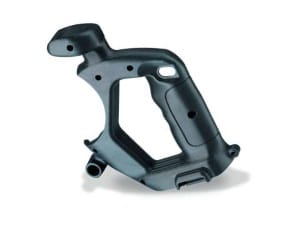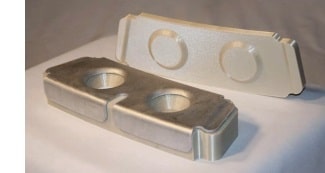Stratasys Materials: When to use Polycarbonate, PC-ABS, and Nylon
 When you purchase a Stratasys FDM (Fused Deposition Modeling) 3D printer, your material options may seem endless, but it’s important to make sure you’re using the best Stratasys materials for your FDM applications. In my previous blog, I discussed understanding ABS, ASA, and PLA Stratasys FDM materials. Today, we’re going to focus on Polycarbonate, PC-ABS, and Nylon materials, available to Fortus customers as the Engineering Bundle. Let’s take a look.
When you purchase a Stratasys FDM (Fused Deposition Modeling) 3D printer, your material options may seem endless, but it’s important to make sure you’re using the best Stratasys materials for your FDM applications. In my previous blog, I discussed understanding ABS, ASA, and PLA Stratasys FDM materials. Today, we’re going to focus on Polycarbonate, PC-ABS, and Nylon materials, available to Fortus customers as the Engineering Bundle. Let’s take a look.
Stratasys Polycarbonate Materials
 Polycarbonate materials are so named for their structure of repeating carbonate monomers. Better known by the SABIC trademark Lexan®, Polycarbonate (PC) is extremely popular in industry due to its high strength, impact resistance, and ease of working. Like other Amorphous polymers, PC Stratasys material 3D prints quite well, as long as shrink is well controlled (as it is in Stratasys FDM 3D printers). For this reason, it is not commonly printed by open-frame consumer printers.
Polycarbonate materials are so named for their structure of repeating carbonate monomers. Better known by the SABIC trademark Lexan®, Polycarbonate (PC) is extremely popular in industry due to its high strength, impact resistance, and ease of working. Like other Amorphous polymers, PC Stratasys material 3D prints quite well, as long as shrink is well controlled (as it is in Stratasys FDM 3D printers). For this reason, it is not commonly printed by open-frame consumer printers.
Polycarbonate (PC) is available in white on all Fortus Production systems (from Fortus 380 to F900) and prints with either breakaway PC Support (with standard T16 tips) or soluble SR-100 (with T12-SR100 tips), in layers 0.007-0.013in thick. From an operational standpoint, PC is easy to use, using the same foundation/build sheets as ABS and ASA. PC flows quite well, which lends itself well to solid prints or high-density sparse infills. Seams (e.g., start/stop points) tend to under-extrude in some situations, so it is worthwhile to process parts in Insight with multiple contours or consider building with a purge tower to prime the nozzle immediately prior to each layer. Also, it should be noted that PC is prone to thermal shock, so it’s best to avoid placing hot parts into a cold cleaning tank, or visa versa, to avoid cracking.
 At 280°F (loaded to 66psi), PC has the highest Heat Deflection Temperature of any Stratasys thermoplastic short of the “High Performance” materials. It’s also exceptionally strong in compression, with solid parts loading without deformation up to five tons per cubic inch. This, along with great wear characteristics, makes it the go-to choice for hydroforming and stamping tools; and a great value (less than 15% higher price than ABS-M30 or ASA) as compared to traditional steel tooling. In addition to tooling, workholding/fixturing and part alignment are excellent high wear applications for Polycarbonate. It’s also an excellent electrostatic insulator. If printed parts are to be used in contact with food, a biocompatible ISO 10993 USP Class VI -certified Polycarbonate is available as PC-ISO.
At 280°F (loaded to 66psi), PC has the highest Heat Deflection Temperature of any Stratasys thermoplastic short of the “High Performance” materials. It’s also exceptionally strong in compression, with solid parts loading without deformation up to five tons per cubic inch. This, along with great wear characteristics, makes it the go-to choice for hydroforming and stamping tools; and a great value (less than 15% higher price than ABS-M30 or ASA) as compared to traditional steel tooling. In addition to tooling, workholding/fixturing and part alignment are excellent high wear applications for Polycarbonate. It’s also an excellent electrostatic insulator. If printed parts are to be used in contact with food, a biocompatible ISO 10993 USP Class VI -certified Polycarbonate is available as PC-ISO.
Stratasys PC-ABS Material
PC-ABS is an alloy of Polycarbonate and ABS and represents a happy medium between the two. It’s 30% stronger than ABS, with a 13% higher heat tolerance, while more ductile and resilient than PC. Black PC-ABS is available on all Production FDM machines, using standard tips (T10-T20) and foundation sheets. And because PC-ABS is available on the Stratasys F370 (in black and white), it affords an upgrade in performance at a low equipment price point. While it can be considered a step-up from ABS in all applications, PC-ABS is especially well-suited to non-marring fixtures and nests, and the higher heat capacity can make it a good choice for some weld fixture applications. And, since PC-ABS can be solvent-smoothed/sealed, it’s a good choice for watertight parts, or prototyping applications requiring parts to be somewhat flexible.
Stratasys Nylon Material

Once a Du Pont trademark, the name Nylon is now synonymous with the class of polymers known as Polyamides. Whereas most Stratasys FDM materials are categorized as “amorphous” polymers, nylons are “semi-crystalline” since their molecular structure is able to form ordered crystalline structures. These crystalline structures are what allow nylon materials to remain exceptionally strong when drawn into extremely thin fibers; hence their popularity in the textile industry. In 3D printing, nylons mostly behave as amorphous polymers, but printed parts can be annealed to form crystalline structures, dramatically improving their strength, heat resistance, and isotropy.
Nylon12 is available in black on all Stratasys Production FDM machines. It prints with standard tips in 0.007-0.013in layers on special build sheets, with soluble SR-110 support material (T12-SR100 tip). Nylons are especially hygroscopic (they absorb moisture from the air) and must be kept dry to print well (same with the build sheets). Be sure to keep the canister sealed while in the machine by keeping the canister door closed (with the center seal removed), and keep the canister fully sealed when not in use. After printing, all Nylon parts should be soaked for at least 4hrs to rehydrate the part in order to ensure maximum part strength. Although Nylon parts generally print quite well, a sacrificial tower can help ensure good surface quality (especially when parts are relatively far from the purge position. Be sure to refer to Stratasys best practices to get the most out of Nylon12.
Nylon is tough! It’s more ductile and fatigue-resistant than PC-ABS, with better chemical resistance. For functional prototypes with living hinges and snap-fit features, Nylon12 is the best choice. But it also excels in low-heat, low-load fixturing applications where a non-marring surface is required.
 Also available for the Fortus 900MC (and F900) is black Nylon6 for 0.010 and 0.013in layer heights. Like Nylon12, Nylon6 is exceptionally ductile, but has ~50% higher strength and heat resistance than Nylon12, with almost twice the stiffness. So, while it may be considered an upgrade from Nylon12 in many applications, it’s also better-suited to tooling applications. Jigs and ergos that need to be stiff but still survive rough handling and drops are great for Nylon6, as are high-load nests/cradles and applications in high ambient heat.
Also available for the Fortus 900MC (and F900) is black Nylon6 for 0.010 and 0.013in layer heights. Like Nylon12, Nylon6 is exceptionally ductile, but has ~50% higher strength and heat resistance than Nylon12, with almost twice the stiffness. So, while it may be considered an upgrade from Nylon12 in many applications, it’s also better-suited to tooling applications. Jigs and ergos that need to be stiff but still survive rough handling and drops are great for Nylon6, as are high-load nests/cradles and applications in high ambient heat.
To summarize, engineering thermoplastics are ideal when strength, rigidity, and durability requirements rule out standard ABS, ASA, and PLA plastics, and are well-suited to functional prototypes and end-use parts. But for applications with very special requirements, it’s time to enter the realm of High-Performance Stratasys materials; that’ll be the subject of my next article.
Related Articles
Know Your Stratasys FDM Materials: ABS, ASA, and PLA
How to Keep Your 3D Printer in Tip-Top Shape
About the Author
Dan Erickson is a student of life. With a BS in Mechanical Engineering Technology from Michigan Tech University and a penchant for tinkering, he is driven to understand how the world works and improve wherever possible. After several career iterations, Dan came to Fisher Unitech in 2011 as a SOLIDWORKS Support Engineer. He has since followed his passion for transformative technology to the 3D Printing department, supporting the Sales and Marketing teams as 3DP Application Engineer.
is a student of life. With a BS in Mechanical Engineering Technology from Michigan Tech University and a penchant for tinkering, he is driven to understand how the world works and improve wherever possible. After several career iterations, Dan came to Fisher Unitech in 2011 as a SOLIDWORKS Support Engineer. He has since followed his passion for transformative technology to the 3D Printing department, supporting the Sales and Marketing teams as 3DP Application Engineer.

 Blog
Blog